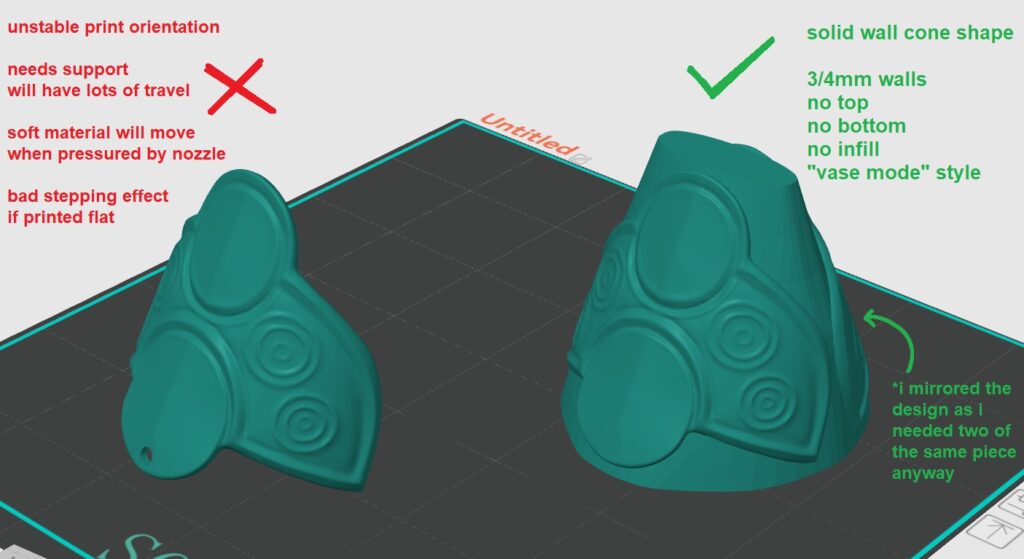- Version
- Download 213
- File Size 1.06 KB
- File Count 1
- Create Date 20/02/2025
- Last Updated 05/05/2025
Orca Slicer and Cura filament presets for Varioshore TPU + tips for cosplay application
Orca Slicer and Cura slicer presets for Varioshore TPU. May fit multiple nozzle sizes (0.4 to 0.6 nozzle recommended).
This is a zip file as the file format is not supported by my website, you need to extract it first before importing the file in Orca Slicer or Cura slicer. Use winzip or 7zip to do that.
To import the profile, start your slicer, go to "File" menu, select import, select import configs.
Made with Orca Slicer version 2.2.0
Critical (Orca) settings for Varioshore TPU:
0.6 to 0.7 flow rate
Max volumetric speed: 5 mm^3/s
Retraction off (retraction 0)
240C-245C temperature
Bed temperature off
Seam position: Nearest
Avoid crossing walls: on
Apply gap infill: nowhere
Ensure vertical shell thickness: none
Speed: 20mm/s to 35mm/s
No support (use designs that have 50 degrees or less overhang)
Rest can be standard preset.
If you must print multiple objects, see if you can print them per object sequence, not by layer. This reduces stringing when the printer moves between objects.
Same for designs that would require the printer to jump/bridge between different elements.
Retraction tips:
If you do want retraction (not recommended, as it can easily clog), i recommend a long wipe distance, fairly fast retract speed, and a slow deretract speed, and spiral z-hop movement. Do 100% retraction before wipe move.
Run some tests to see how well it performs.
This filament is recommended for direct drive printers only. There is no need for an enclosure, heated bed or specific fan requirements.
Optimize your design to have little to no overhangs, maximum ~50 degrees overhangs.
Optimize your design to have an "eiffel tower" orientation (cone): widest flat area on the bottom, ending in a smaller area towards the top
Details are best printed vertically, try to avoid near-flat areas that would create stepping layers.
If your part is thin, redesign the part to have a fatter shape either by using extra walls in the 3d design or using an additional cube in the slicer to merge with the design to stabilize the print, then print that cube hollow no infill.
Steep cone-like shapes have the best quality results.
You can cut away this material easily with sturdy scissors, take advantage of this by merging support structures with the actual design itself.
See example below of how I redesigned this piece to have the supreme best surface quality with vertical wall structure and stable cone shape (zero bottom or top layers):

Tips for post-processing varioshore for cosplay painting:
Varioshore can be cut with sturdy scissors or sharp knives.
Varioshore is very similar to eva foam, as such you can use almost all eva foam techniques cosplayers often use such as dremel sanding, flexible fillers and flexible primers/paints.
Recommended products:
Sand rough areas and visible layer lines: Dremel with sanding drum and/or abrasive polishing wheel
Filling holes/large gaps: flexible modeling paste (liquitex), acrylic caulk (such as kwikseal), a 3dpen loaded with varioshore
Flexible eva foam primers: plastidip (spray or liquid), flexbond, woodglue/white glue/elmers glue, modpodge, folkart clear primer, also recently tested krylon triple glaze spray with great success.
Flexible paints: high quality acrylics, cosplay paints like plaidfx, flexipaint, hexflex paint, acrylic spraypaints (NO automotive or lacquer spray paints)
To glue or bond pieces, you can melt two areas together with a hot knife/3dpen/cheap soldering iron or use a rubber toughened AC glue (IC2000, tire glue). You can also sew and/or rivet thin areas. I haven't always had success with contact cement.